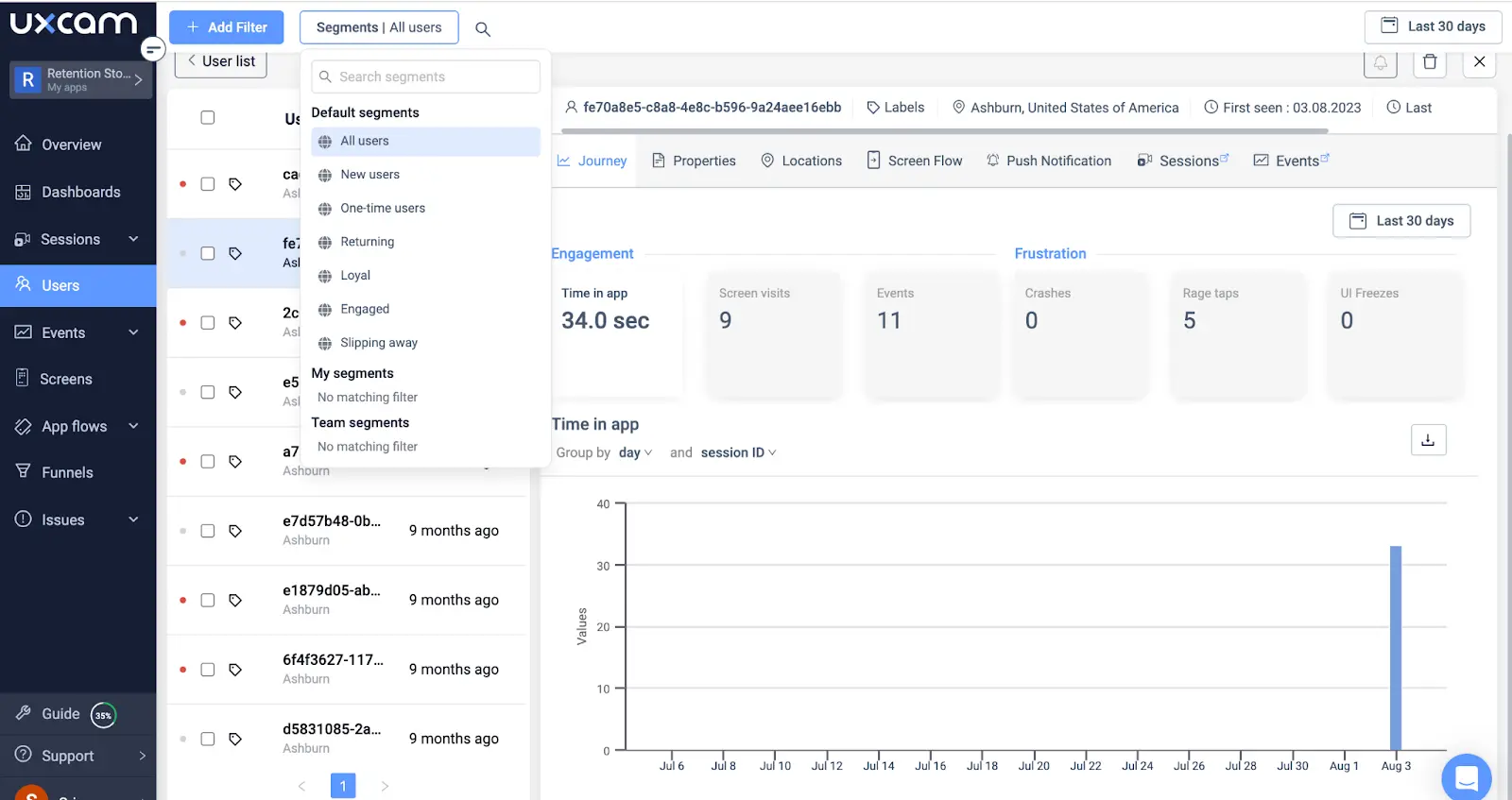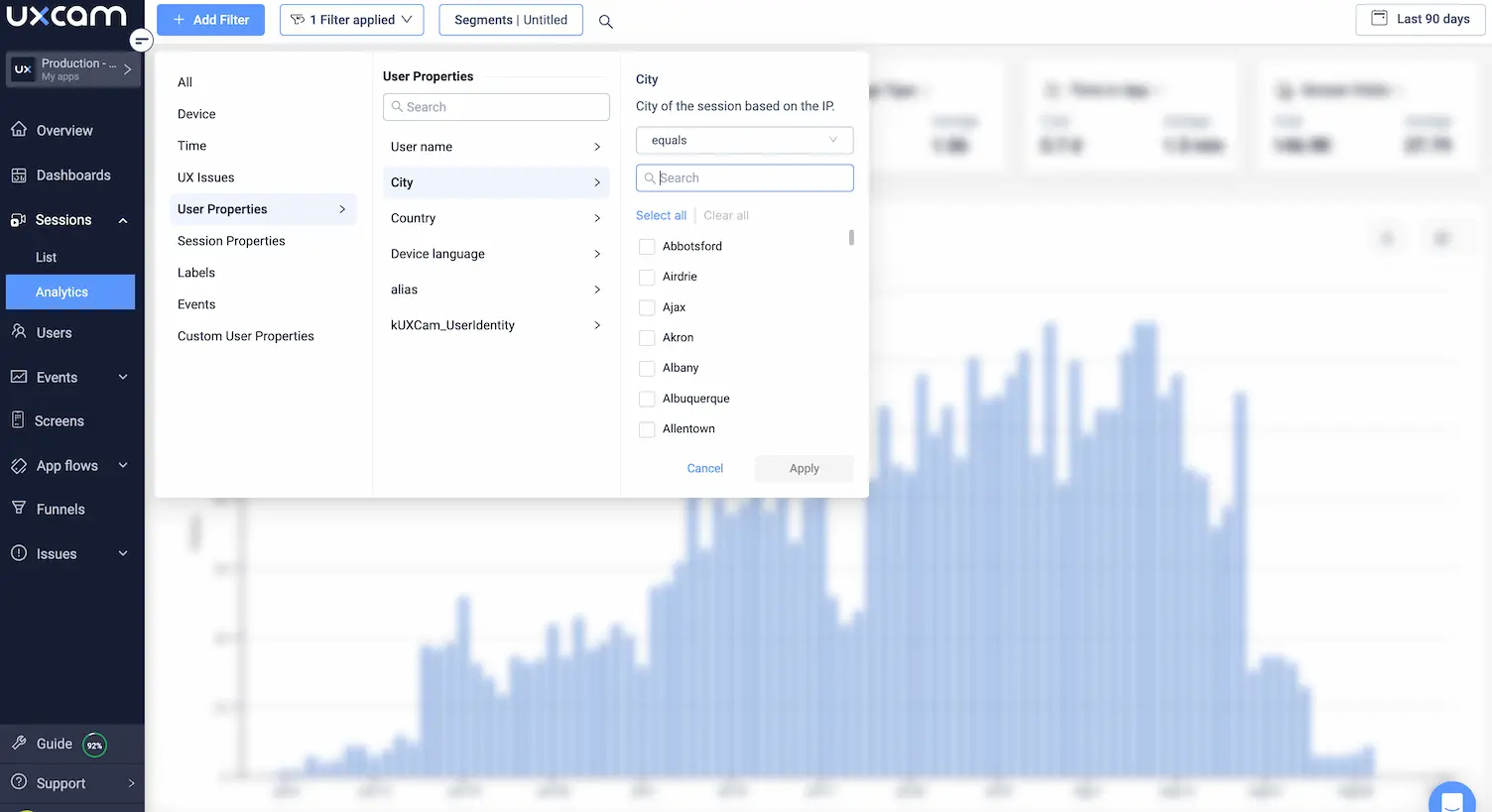Back to blog
5 MIN READ
User Personas: A Guide to Creating User-Centric Apps
PUBLISHED
26 September, 2023

Product Analytics Expert
The digital age has ushered in a user-centric era, where the success of an app hinges on its ability to resonate with its audience. As such, it is increasingly important for developers to create apps that respond to the needs and behaviors of their users.
Crafting user personas is a great way to ensure an app resonates with its user base.
In this UXCam guide, we'll explore how crafting user personas can be your compass for creating apps that address user demands.
Let’s get started.
What are user personas?
User personas are fictional representations of your “ideal user”.
They’re fictional in that they’re usually generalizations of large user segments rather than descriptions of existing users.
Don’t let the word fictional fool you, though—creating user personas is a systematic, data-driven process that draws on analytics tools like UXCam, market research, user interviews, and other sources of customer feedback.

A good user persona aims to answer three key questions about a segment:
Who are you?
What’s your main goal?
What’s the main obstacle standing in your way?
Different types of user personas
1. Goal-directed personas
Goal-directed personas are users with a specific purpose in mind. These personas are often motivated by a need for quick and efficient results. They prioritize ease of use when choosing an app or product, as they usually don’t have the time or patience to struggle to complete tasks.
Housing.com used UXCam to create goal-based personas that focused on their development process. They zoomed in on user behavior using session replays and funnels and ultimately found that one particular mobile segment was interested in searching for properties in multiple cities simultaneously. Making the process easier for this segment dramatically improved user engagement.
2. Role-based user personas
Role-based personas are users who have a specific set of characteristics or roles. These personas can help decision-makers understand how different user types interact with their products, making it easier to create content and features that are tailored to particular user segments.
For example, one segment of users might use your project management tool for work, while another might use it for personal projects. Illustrating these segments with personas can help you design content and features that resonate as intended.
3. Engaging user personas
Engaging personas blend the dimensions of goal-directed and role-based personas, culminating in a multifaceted perspective that encapsulates users' holistic experiences. These personas are crafted to resonate with designers, instilling a sense of connection and involvement.
Why are user personas important?
We could go on and on about the benefits of user personas—but in the interest of brevity, we’ll stick with the highlights.
The biggest benefit of clearly denied personas is an enhanced ability to personalize your product. The more refined and representative your user personas, the more your product will feel like it was designed just for a particular user. This can make users feel seen, heard, and appreciated.
User personas also help keep focus on the end goal of providing an enjoyable user experience. With clearly laid out goals and objectives, you’ll have a better chance of creating content that resonates with your target audience—not to mention helping them achieve their goals more quickly.
How to create user personas
Step 1 - Gather Data
All user personas are based on data. The sources for this data vary based on the state of your product.
Pre-deployment products
At this stage, you (unfortunately) don’t have any user data to draw from. However, you do have a number of other data sources that can provide some insights:
Competitors: This should be your starting point. Use competitor research tools like App Radar (mobile apps) or Similarweb (web apps) to gain broad insights into the kinds of people who use their products.
Surveys: Use tools like Attest to target the characteristics you identified in the competitor research stage with surveys that deepen your understanding.
Interviews: Once you’ve gotten the broad characteristics of your target user, use interviews with people who fit that description to gain in-depth insights and validate assumptions.
Post-deployment products
An active user base is the best data source for persona creation.
Using your product analytics tool, look for insights into who uses the product, how they use it, and which features they engage with most.
UXCam is a great tool for this.
Features like session replays, heatmaps, event logs, and frustration signals allow you to see how people use your product and identify areas for improvement. Plus, metrics and reports make it easy to segment users, analyze their behavior, and track trends over time.
Combine this data with other sources like user surveys and interviews to further refine your personas and deepen your understanding of user behavior.
Step 2 - Analyze data
Once you’ve gathered data, it’s time to start analyzing.
At this stage, you’re looking for similarities between customer segments that can help inform your product roadmap. This is a balancing act—you want to be forgiving enough to narrow it down to a few core patterns but specific enough to create meaningful personas.
A segmentation tool like UXCam can help you quickly identify and visualize patterns in your data. Quickly identify meaningful segments using any in-app characteristic or trait and save them for future use.

Step 3 - Create personas
With the data collected and analyzed, you can form customer personas to understand user types and their needs better.
Personas provide a human face to your data points, allowing stakeholders to empathize with users to create a more tailored experience. Include as many details about each persona as possible, including:
Age
Job
Goal(s)
Pain Point(s)
This may not be an exhaustive list—some niche products will need to add more categories to create meaningful personas. For example, if you’re building a physical therapy app for seniors, you’ll probably want to include categories like “mobility level” and “pre-existing conditions”.
Step 4 - Give your persona a narrative
It’s difficult to connect with a stat sheet. To bring your personas to life, give them a narrative or backstory.
A good persona will have a detailed story of why they use the product and how they interact with it. It should be detailed enough that stakeholders can picture their customers in their mind’s eye.
For example:
Age: 35-45
Job: Director of IT at a medium-sized company
Goal(s): Wants to simplify IT project management
Pain Point(s): Struggles to assign tasks and track progress
Backstory: Ted has been a director of IT at his company for the past five years. He constantly looks for ways to make project management easier and more efficient. He needs an IT solution to help him delegate tasks, monitor IT assets, manage/schedule audits, and keep track of progress. Currently, there are no IT-focused tools that need these needs.
Conclusion
User personas are your secret weapon in the world of mobile app design. By truly understanding your users, you can create products that meet their needs, resulting in improved retention, increased lifetime value, and boosted sales.
Embrace the power of user personas with the help of UXCam, the tool that grants you unparalleled insights into user behavior. Craft experiences that resonate with your target audience, and remember—understanding your users is the key to app success.
Sign up for free trial now. You may also be interested in these;
Understanding user experience management: The ultimate guide
User segmentation examples - From data to action
AUTHOR

Tope Longe
Product Analytics Expert
Ardent technophile exploring the world of mobile app product management at UXCam.
What’s UXCam?
Related articles
UX design
Auditoria de UX – Como Realizar uma (Etapas, Modelos e Checklist)
Navegue por auditorias de UX com facilidade usando nosso guia para iniciantes, com instruções passo a passo, modelos personalizáveis e um checklist...

Tope Longe
Product Analytics Expert
UX design
UX Audit - How to Conduct One (Steps, Templates & Checklist)
Navigate UX audits effortlessly with our beginner's guide, offering step-by-step instructions, customizable templates, and a detailed...

Tope Longe
Product Analytics Expert
UX design
12 UX Metrics to Measure and Enhance User Experience
Unlock product success by tracking the right UX metrics. Learn 12 essential metrics, how to measure them, avoid common pitfalls, and take action with tools like...